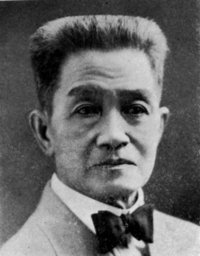Emilio Aguinaldo - First President of the Philippines
Born in Kawit, Cavite on March 30, 1869, Emilio Aguinaldo holds the distinction of being the first Philippine president and one of the guiding forces of Philippine independence.
General Aguinaldo studied in the private schools of his hometown and later at San Juan de Letran in Manila. He returned to Kawit prior his graduation from Letran and actively engaged in farming activities.

|
Revolution
Emilio Aguinaldo joined the 1896 revolution as a lieutenant under his brother Baldomero’s regiment. His active participation and meritorious service lead to his promotion to the rank of General in a few months time.
General Aguinaldo personally conducted the military operations against the Spaniards until the Pact of Biak na Bato in December of 1897. Among the proviso of the pact were: Aguinaldo and some of his high ranking officials would leave the country and that the Spanish government would indemnify the revolutionaries with P800,000.
Fulfilling the conditions of the pact, General Aguinaldo and some other 25 men went to Hong Kong. The General received half of the amount of the indemnity and the funds were used to finance the reorganized revolution.
General Emilio Aguinaldo subsequently returned to the Philippines at the onset of the Spanish-American war. Two weeks after his arrival, the Filipino uprising against Spain was renewed. He subsequently resumed his post to command the revolutionary forces in the Philippines.
Independence
On June 12, 1898, General Aguinaldo proclaimed the independence of the Philippines from under Spanish colonial rule.
The Act of Declaration of Philippine Independence was read on the same occasion at the home of the General in Kawit.
By June 18, the president issued a decree establishing his dictatorial government and on June 23, he issued a decree which changed the form of government from dictatorial to revolutionary, making him the first Philippine president.
The first Philippine Republic was formally established together with the Malolos Constitution on January 21, 1899.
The first republic remained until the General’s capture on March 23, 1901 by American soldiers in Palanan, Isabela.
Thereafter, he was confined at Malacañang Palace and on April 19, 1901, took the oath of allegiance to the United States, thereby ending the First Philippine Republic and accepting the American rule in the Philippines.
Later Years
General Aguinaldo retired from public life and supported the advocacy for Philippine independence and assisted the veterans of the revolution.
He spearheaded the Association of Veterans in securing pensions and lot acquisition for its members.
In 1935, he returned to public life by running for the Presidency of the Commonwealth, however he lost to Manuel Quezon.
During World War II, he sided and cooperated with the Japanese forces by soliciting support for the Japanese causes through speeches and articles.
After the war, he was arrested by the Americans together with other Japanese collaborators and was jailed. He was later released by means of Presidential amnesty. At age 77, he witnessed the Philippines independence from American rule.
General Emilio Aguinaldo was later appointed as a member of the Council of State under the Quirino Presidency. The General died on February 6, 1964 due to coronary thrombosis.


